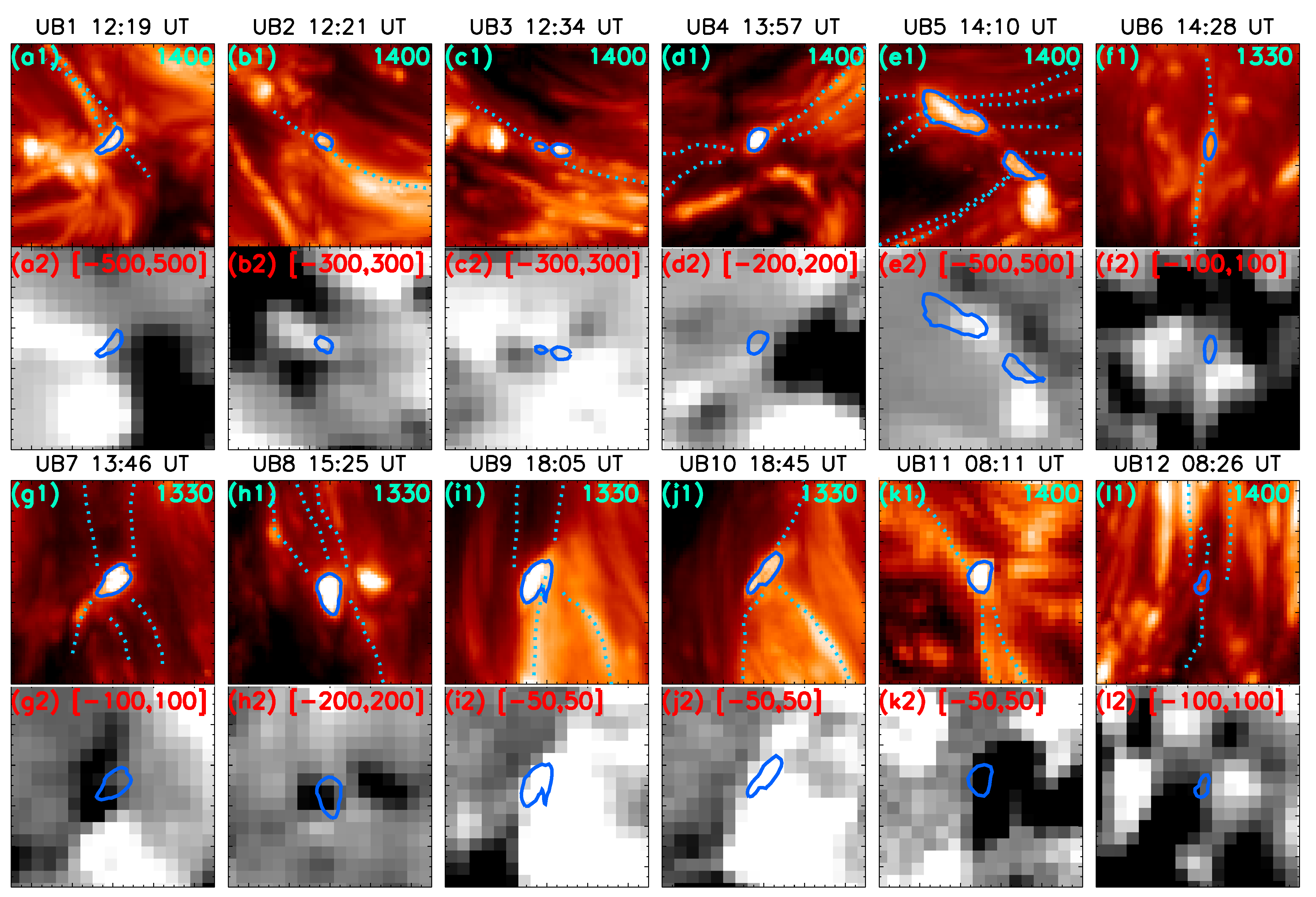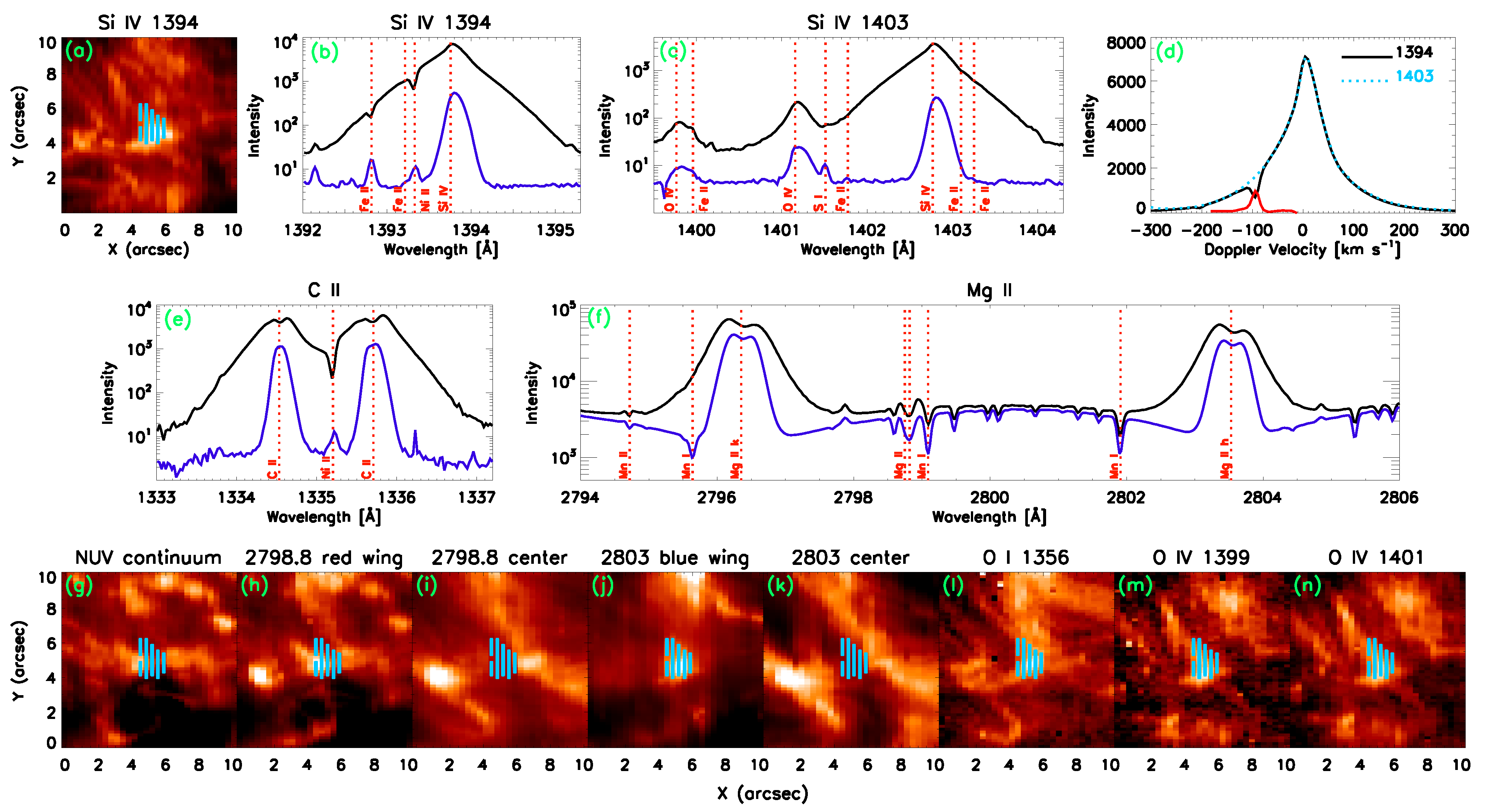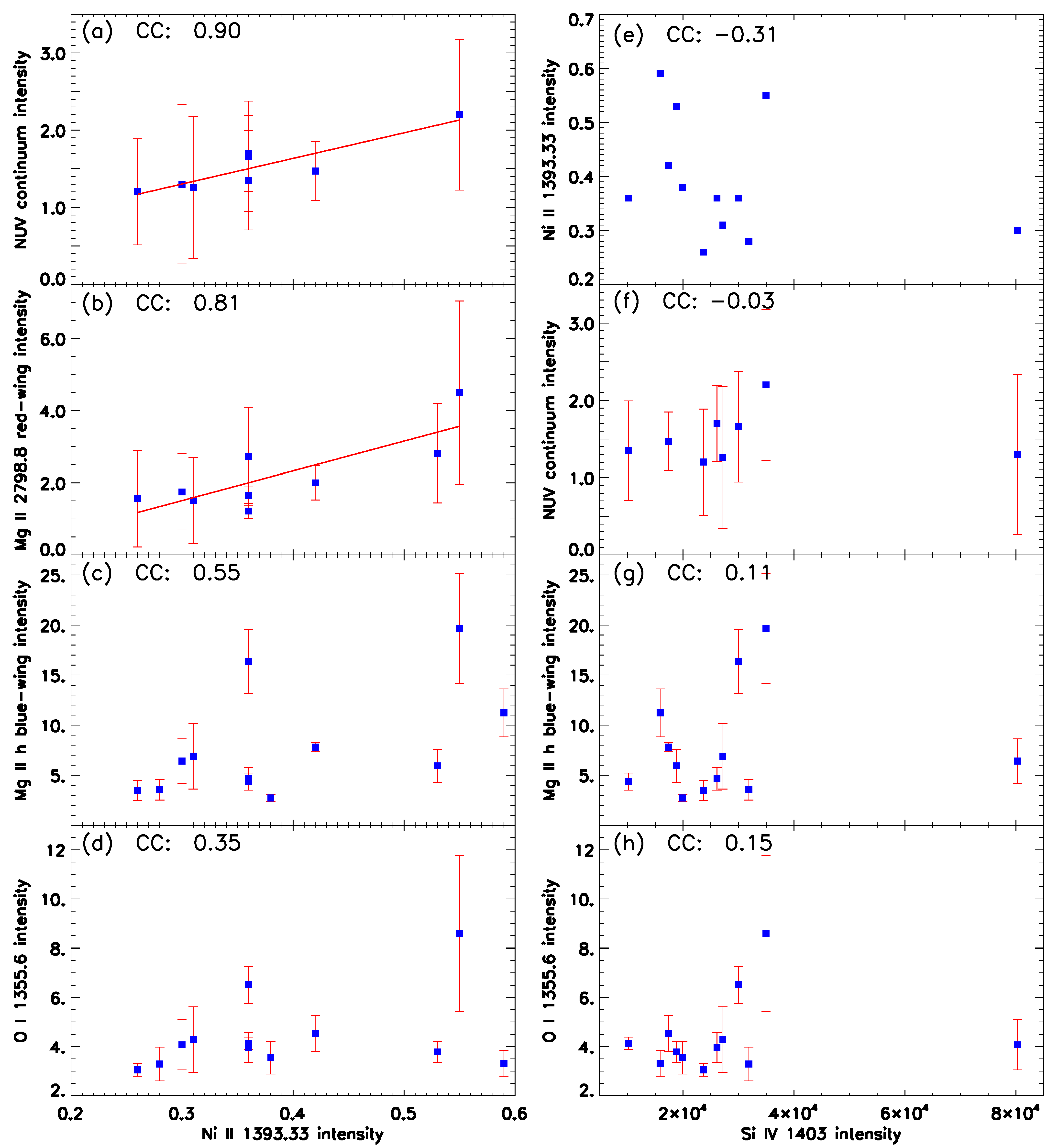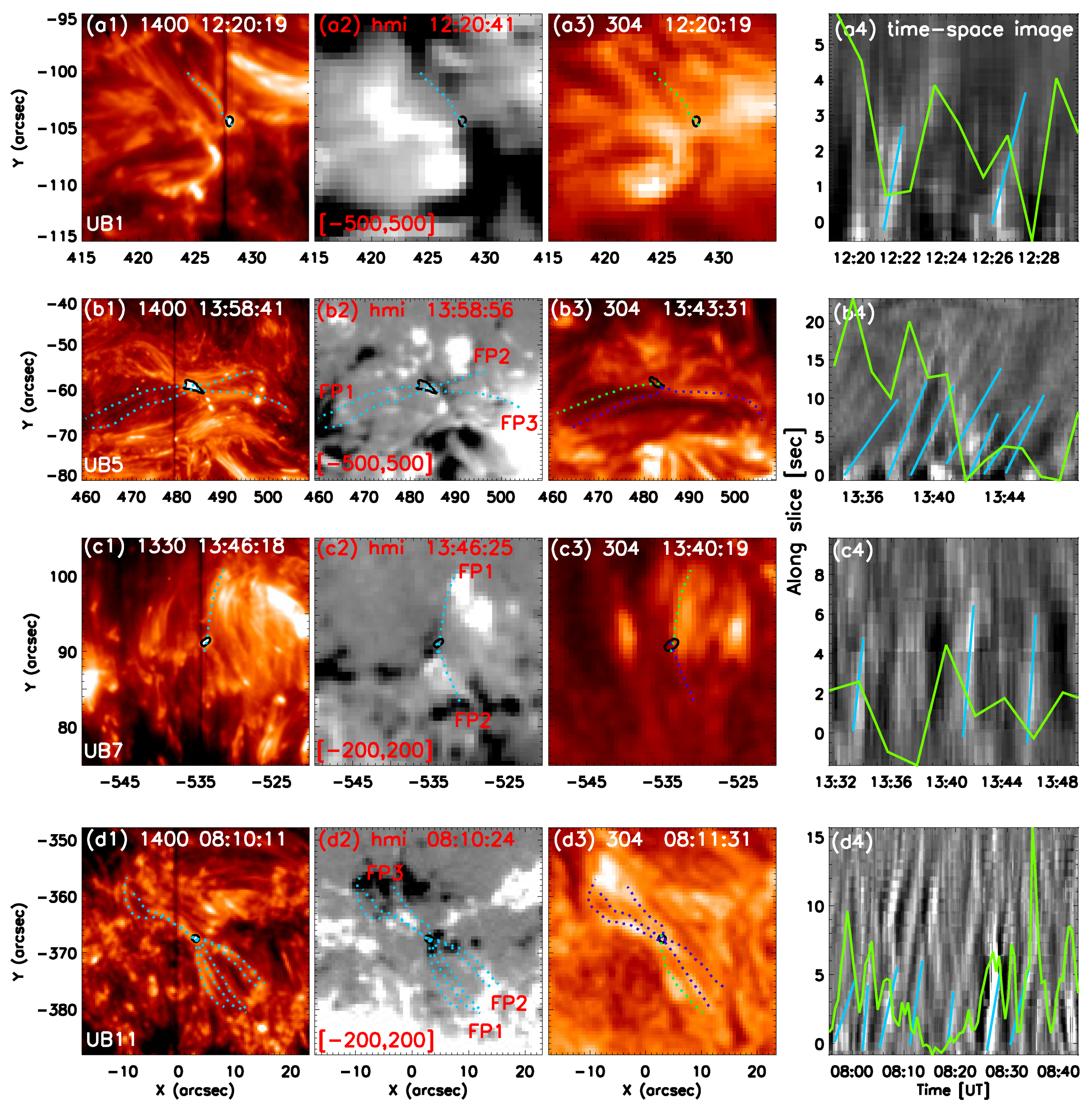Solar Ultraviolet Bursts in the Joint Footpoints of Multiple Transition Region Loops
Abstract
:1. Introduction
2. Observations and Data Analysis
3. Results
3.1. Spectral Characteristics
3.2. Activities of the Transition Region Loops Associated with UBs
4. Discussion and Conclusions
Author Contributions
Funding
Data Availability Statement
Acknowledgments
Conflicts of Interest
Appendix A. The Relative Intensity of Ni ii Absorption
References
- Young, P.R.; Tian, H.; Peter, H.; Rutten, R.J.; Nelson, C.J.; Huang, Z.; Schmieder, B.; Vissers, G.J.M.; Toriumi, S.; Rouppe van der Voort, L.H.M.; et al. Solar Ultraviolet Bursts. Space Sci. Rev. 2018, 214, 120. [Google Scholar] [CrossRef] [Green Version]
- Chen, P.F. Coronal Mass Ejections: Models and Their Observational Basis. Living Rev. Sol. Phys. 2011, 8, 1. [Google Scholar] [CrossRef] [Green Version]
- Shibata, K.; Magara, T. Solar Flares: Magnetohydrodynamic Processes. Living Rev. Sol. Phys. 2011, 8, 6. [Google Scholar] [CrossRef] [Green Version]
- Hou, Z.; Huang, Z.; Xia, L.; Li, B.; Madjarska, M.S.; Fu, H.; Mou, C.; Xie, H. Narrow-line-width UV Bursts in the Transition Region above Sunspots Observed by IRIS. Astrophys. J. Lett. 2016, 829, L30. [Google Scholar] [CrossRef] [Green Version]
- Peter, H.; Tian, H.; Curdt, W.; Schmit, D.; Innes, D.; De Pontieu, B.; Lemen, J.; Title, A.; Boerner, P.; Hurlburt, N.; et al. Hot explosions in the cool atmosphere of the Sun. Science 2014, 346, 1255726. [Google Scholar] [CrossRef] [PubMed] [Green Version]
- De Pontieu, B.; Title, A.M.; Lemen, J.R.; Kushner, G.D.; Akin, D.J.; Allard, B.; Berger, T.; Boerner, P.; Cheung, M.; Chou, C.; et al. The Interface Region Imaging Spectrograph (IRIS). Sol. Phys. 2014, 289, 2733–2779. [Google Scholar] [CrossRef]
- Ellerman, F. Solar Hydrogen “bombs”. Astrophys. J. 1917, 46, 298. [Google Scholar] [CrossRef]
- Fang, C.; Tang, Y.H.; Xu, Z.; Ding, M.D.; Chen, P.F. Spectral Analysis of Ellerman Bombs. Astrophys. J. 2006, 643, 1325–1336. [Google Scholar] [CrossRef] [Green Version]
- Rutten, R.J.; Vissers, G.J.M.; Rouppe van der Voort, L.H.M.; Sütterlin, P.; Vitas, N. Ellerman bombs: Fallacies, fads, usage. J. Phys. Conf. Ser. 2013, 440, 012007. [Google Scholar] [CrossRef] [Green Version]
- Yang, H.; Chae, J.; Lim, E.K.; Park, H.; Cho, K.; Maurya, R.A.; Song, D.; Kim, Y.H.; Goode, P.R. Velocities and Temperatures of an Ellerman Bomb and Its Associated Features. Sol. Phys. 2013, 288, 39–53. [Google Scholar] [CrossRef]
- Hong, J.; Ding, M.D.; Cao, W. Multi-wavelength Spectral Analysis of Ellerman Bombs Observed by FISS and IRIS. Astrophys. J. 2017, 838, 101. [Google Scholar] [CrossRef] [Green Version]
- Nelson, C.J.; Shelyag, S.; Mathioudakis, M.; Doyle, J.G.; Madjarska, M.S.; Uitenbroek, H.; Erdélyi, R. Ellerman Bombs—Evidence for Magnetic Reconnection in the Lower Solar Atmosphere. Astrophys. J. 2013, 779, 125. [Google Scholar] [CrossRef] [Green Version]
- Kim, Y.H.; Yurchyshyn, V.; Bong, S.C.; Cho, I.H.; Cho, K.S.; Lee, J.; Lim, E.K.; Park, Y.D.; Yang, H.; Ahn, K.; et al. Simultaneous observation of a hot explosion by NST and IRIS. Astrophys. J. 2015, 810, 38. [Google Scholar] [CrossRef]
- Vissers, G.J.M.; Rouppe van der Voort, L.H.M.; Rutten, R.J.; Carlsson, M.; De Pontieu, B. Ellerman Bombs at High Resolution. III. Simultaneous Observations with IRIS and SST. Astrophys. J. 2015, 812, 11. [Google Scholar] [CrossRef] [Green Version]
- Liu, Z.; Xu, J.; Gu, B.Z.; Wang, S.; You, J.Q.; Shen, L.X.; Lu, R.W.; Jin, Z.Y.; Chen, L.F.; Lou, K. New vacuum solar telescope and observations with high resolution. Res. Astron. Astrophys. 2014, 14, 705–718. [Google Scholar] [CrossRef]
- Tian, H.; Xu, Z.; He, J.; Madsen, C. Are IRIS Bombs Connected to Ellerman Bombs? Astrophys. J. 2016, 824, 96. [Google Scholar] [CrossRef] [Green Version]
- Chen, Y.; Tian, H.; Peter, H.; Samanta, T.; Yurchyshyn, V.; Wang, H.; Cao, W.; Wang, L.; He, J. Flame-like Ellerman Bombs and Their Connection to Solar Ultraviolet Bursts. Astrophys. J. 2019, 875, L30. [Google Scholar] [CrossRef]
- Toriumi, S.; Katsukawa, Y.; Cheung, M.C.M. Light Bridge in a Developing Active Region. I. Observation of Light Bridge and its Dynamic Activity Phenomena. Astrophys. J. 2015, 811, 137. [Google Scholar] [CrossRef] [Green Version]
- Tian, H.; Yurchyshyn, V.; Peter, H.; Solanki, S.K.; Young, P.R.; Ni, L.; Cao, W.; Ji, K.; Zhu, Y.; Zhang, J.; et al. Frequently Occurring Reconnection Jets from Sunspot Light Bridges. Astrophys. J. 2018, 854, 92. [Google Scholar] [CrossRef] [Green Version]
- Vissers, G.J.M.; de la Cruz Rodríguez, J.; Libbrecht, T.; Rouppe van der Voort, L.H.M.; Scharmer, G.B.; Carlsson, M. Dissecting bombs and bursts: Non-LTE inversions of low-atmosphere reconnection in SST and IRIS observations. Astron. Astrophys. 2019, 627, A101. [Google Scholar] [CrossRef]
- Ni, L.; Lin, J.; Roussev, I.I.; Schmieder, B. Heating Mechanisms in the Low Solar Atmosphere through Magnetic Reconnection in Current Sheets. Astrophys. J. 2016, 832, 195. [Google Scholar] [CrossRef] [Green Version]
- Ni, L.; Lukin, V.S.; Murphy, N.A.; Lin, J. Magnetic Reconnection in Strongly Magnetized Regions of the Low Solar Chromosphere. Astrophys. J. 2018, 852, 95. [Google Scholar] [CrossRef] [Green Version]
- Ni, L.; Lukin, V.S. Onset of Secondary Instabilities and Plasma Heating during Magnetic Reconnection in Strongly Magnetized Regions of the Low Solar Atmosphere. Astrophys. J. 2018, 868, 144. [Google Scholar] [CrossRef] [Green Version]
- Ni, L.; Lukin, V.S.; Murphy, N.A.; Lin, J. Magnetic reconnection in the low solar chromosphere with a more realistic radiative cooling model. Phys. Plasmas 2018, 25, 042903. [Google Scholar] [CrossRef] [Green Version]
- Rouppe van der Voort, L.; De Pontieu, B.; Scharmer, G.B.; de la Cruz Rodríguez, J.; Martínez-Sykora, J.; Nóbrega-Siverio, D.; Guo, L.J.; Jafarzadeh, S.; Pereira, T.M.D.; Hansteen, V.H. Intermittent Reconnection and Plasmoids in UV Bursts in the Low Solar Atmosphere. Astrophys. J. 2017, 851, L6. [Google Scholar] [CrossRef] [Green Version]
- Hansteen, V.H.; Archontis, V.; Pereira, T.M.D.; Carlsson, M.; Rouppe van der Voort, L.; Leenaarts, J. Bombs and Flares at the Surface and Lower Atmosphere of the Sun. Astrophys. J. 2017, 839, 22. [Google Scholar] [CrossRef] [Green Version]
- Hansteen, V.; Ortiz, A.; Archontis, V.; Carlsson, M.; Pereira, T.M.D.; Bjørgen, J.P. Ellerman bombs and UV bursts: Transient events in chromospheric current sheets. Astron. Astrophys. 2019, 626, A33. [Google Scholar] [CrossRef] [Green Version]
- Huang, Z. Magnetic Loops above a Small Flux-emerging Region Observed by IRIS, Hinode, and SDO. Astrophys. J. 2018, 869, 175. [Google Scholar] [CrossRef] [Green Version]
- Huang, Z.; Li, B.; Xia, L.; Shi, M.; Fu, H.; Hou, Z. Transition Region Loops in the Very Late Phase of Flux Emergence in IRIS Sit-and-stare Observations. Astrophys. J. 2019, 887, 221. [Google Scholar] [CrossRef]
- Huang, Z.; Madjarska, M.S.; Scullion, E.M.; Xia, L.D.; Doyle, J.G.; Ray, T. Explosive events in active region observed by IRIS and SST/CRISP. Mon. Not. R. Astron. Soc. 2017, 464, 1753–1761. [Google Scholar] [CrossRef] [Green Version]
- Lemen, J.R.; Title, A.M.; Akin, D.J.; Boerner, P.F.; Chou, C.; Drake, J.F.; Duncan, D.W.; Edwards, C.G.; Friedlaender, F.M.; Heyman, G.F.; et al. The Atmospheric Imaging Assembly (AIA) on the Solar Dynamics Observatory (SDO). Sol. Phys. 2012, 275, 17–40. [Google Scholar] [CrossRef] [Green Version]
- Pesnell, W.D.; Thompson, B.J.; Chamberlin, P.C. The Solar Dynamics Observatory (SDO). Sol. Phys. 2012, 275, 3–15. [Google Scholar] [CrossRef] [Green Version]
- Scherrer, P.H.; Schou, J.; Bush, R.I.; Kosovichev, A.G.; Bogart, R.S.; Hoeksema, J.T.; Liu, Y.; Duvall, T.L.; Zhao, J.; Title, A.M.; et al. The Helioseismic and Magnetic Imager (HMI) Investigation for the Solar Dynamics Observatory (SDO). Sol. Phys. 2012, 275, 207–227. [Google Scholar] [CrossRef] [Green Version]
- Huang, Z.; Madjarska, M.S.; Doyle, J.G.; Lamb, D.A. Coronal hole boundaries at small scales. IV. SOT view. Magnetic field properties of small-scale transient brightenings in coronal holes. Astron. Astrophys. 2012, 548, A62. [Google Scholar] [CrossRef]
- Young, P.R.; Keenan, F.P.; Milligan, R.O.; Peter, H. A Si IV/O IV Electron Density Diagnostic for the Analysis of IRIS Solar Spectra. Astrophys. J. 2018, 857, 5. [Google Scholar] [CrossRef]
- Tian, H.; Zhu, X.; Peter, H.; Zhao, J.; Samanta, T.; Chen, Y. Magnetic Reconnection at the Earliest Stage of Solar Flux Emergence. Astrophys. J. 2018, 854, 174. [Google Scholar] [CrossRef] [Green Version]
- Judge, P.G. UV Spectra, Bombs, and the Solar Atmosphere. Astrophys. J. 2015, 808, 116. [Google Scholar] [CrossRef] [Green Version]
- Avrett, E.H.; Loeser, R. Models of the Solar Chromosphere and Transition Region from SUMER and HRTS Observations: Formation of the Extreme-Ultraviolet Spectrum of Hydrogen, Carbon, and Oxygen. Astrophys. J. Suppl. Ser. 2008, 175, 229–276. [Google Scholar] [CrossRef] [Green Version]
- Pereira, T.M.D.; Leenaarts, J.; De Pontieu, B.; Carlsson, M.; Uitenbroek, H. The Formation of IRIS Diagnostics. III. Near-ultraviolet Spectra and Images. Astrophys. J. 2013, 778, 143. [Google Scholar] [CrossRef] [Green Version]
- Pereira, T.M.D.; Carlsson, M.; De Pontieu, B.; Hansteen, V. The Formation of IRIS Diagnostics. IV. The Mg II Triplet Lines as a New Diagnostic for Lower Chromospheric Heating. Astrophys. J. 2015, 806, 14. [Google Scholar] [CrossRef] [Green Version]
- Lin, H.H.; Carlsson, M. The Formation of IRIS Diagnostics. VII. The Formation of the OI 135.56 NM Line in the Solar Atmosphere. Astrophys. J. 2015, 813, 34. [Google Scholar] [CrossRef] [Green Version]
- Leenaarts, J.; Pereira, T.M.D.; Carlsson, M.; Uitenbroek, H.; De Pontieu, B. The Formation of IRIS Diagnostics. II. The Formation of the Mg II h&k Lines in the Solar Atmosphere. Astrophys. J. 2013, 772, 90. [Google Scholar] [CrossRef] [Green Version]
- Guglielmino, S.L.; Zuccarello, F.; Young, P.R.; Murabito, M.; Romano, P. IRIS Observations of Magnetic Interactions in the Solar Atmosphere between Preexisting and Emerging Magnetic Fields. I. Overall Evolution. Astrophys. J. 2018, 856, 127. [Google Scholar] [CrossRef] [Green Version]
- Leenaarts, J.; Pereira, T.M.D.; Carlsson, M.; Uitenbroek, H.; De Pontieu, B. The Formation of IRIS Diagnostics. I. A Quintessential Model Atom of Mg II and General Formation Properties of the Mg II h&k Lines. Astrophys. J. 2013, 772, 89. [Google Scholar] [CrossRef] [Green Version]
- Sainz Dalda, A.; de la Cruz Rodríguez, J.; De Pontieu, B.; Gošić, M. Recovering Thermodynamics from Spectral Profiles observed by IRIS: A Machine and Deep Learning Approach. Astrophys. J. Lett. 2019, 875, L18. [Google Scholar] [CrossRef] [Green Version]
- Pariat, E.; Aulanier, G.; Schmieder, B.; Georgoulis, M.K.; Rust, D.M.; Bernasconi, P.N. Resistive Emergence of Undulatory Flux Tubes. Astrophys. J. 2004, 614, 1099–1112. [Google Scholar] [CrossRef]
- Hou, Z.; Tian, H.; Chen, H.; Zhu, X.; Huang, Z.; Bai, X.; He, J.; Song, Y.; Xia, L. Formation of Solar Quiescent Coronal Loops through Magnetic Reconnection in an Emerging Active Region. Astrophys. J. 2021, 915, 39. [Google Scholar] [CrossRef]




| Data ID | Date and Time (UT) | Target | Raster Maps | Slit–Jaw Imaging Data | |||||
|---|---|---|---|---|---|---|---|---|---|
| AR | X,Y (″) | Mode | Step Size (″) | EXP | Passband [Å] | Cadence [s] | Pixel Size | ||
| DATA1 | 14 February 2014 11:49–15:21 | 11,974 | 481, −98 | 1 raster, 400 steps | 0.35 | 30 s | 1330/1400 | 63 s | 0.17″ × 0.17″ |
| DATA2 | 25 July 2014 13:20–18:58 | 12,121 | −541, 55 | 10 rasters 64 steps | 0.35 | 30 s | 1330/2796/2832 | 127 s | 0.17″ × 0.17″ |
| DATA3 | 5 August 2014 07:55–08:53 | 12,132 | 35, −393 | 1 raster 400 steps | 0.35 | 8 s | 1400/2796/2832 | 35 s | 0.33″ × 0.33″ |
| DATA4 | 20 April 2015 07:59–08:35 | 12,325 | 26, 155 | 1 raster 400 steps | 0.35 | 5 s | 1400/2796/2832 | 21 s | 0.17″ × 0.17″ |
| UB | I | Ratio | O iv | log() | log() | I | V | I | I | Mg ii h Resp. | I | I | LF | B |
|---|---|---|---|---|---|---|---|---|---|---|---|---|---|---|
| () | Emission | [] | [] | [kms] | [kms] | [min] | [G] | |||||||
| 1 | 8.0 | 1.92 | yes | 11.15 | 11.91 | 0.30 (0.026) | −2.8 | 1.30 | 1.75 | [−160, −22][26, 155] | 6.41 | 4.07 | 26 | 480 |
| 2 | 3.0 | 1.94 | yes | 10.47 | 11.91 | 0.36 (0.054) | 0.6 | 1.66 | 2.73 | [−160, −20][25, 155] | 16.37 | 6.51 | 4 | 167 |
| 3 | 2.0 | 1.97 | no | × | × | 0.38 (0.056) | −1.4 | × | × | [−120, −27][26, 130] | 2.72 | 3.55 | 4 | 176 |
| 4 | 2.6 | 1.94 | no | × | × | 0.36 (0.026) | 0.7 | 1.70 | 1.66 | [−160, −25][24, 155] | 4.64 | 3.96 | >20 | 57 |
| 5 | 3.2 | 1.88 | yes | 11.04 | 11.88 | 0.28 (0.059) | −4.6 | × | × | [−100, −22][18, 95] | 3.55 | 3.29 | 108 | 150 |
| 6 | 1.7 | 2.02 | no | × | × | 0.42 (0.043) | −2.6 | 1.47 | 2.00 | [−130, −25][24, 125] | 7.80 | 4.53 | 8. | 30 |
| 7 | 1.9 | 1.85 | no | × | × | 0.53 (0.025) | −1.4 | × | 2.82 | [−120, −23][27, 120] | 5.93 | 3.78 | 60 | −67 |
| 8 | 3.5 | 1.96 | no | × | × | 0.55 (0.021) | 0.6 | 2.20 | 4.50 | [−160, −17][18, 155] | 19.67 | 8.59 | 30 | −184 |
| 9 | 2.7 | 1.99 | only 1401 | × | 12.26 | 0.31 (0.055) | −2.3 | 1.26 | 1.51 | [−145, −20][22, 120] | 6.89 | 4.28 | 120 | 137 |
| 10 | 1.0 | 1.99 | no | × | × | 0.36 (0.112) | 0.1 | 1.35 | 1.22 | [−160, −25][22, 155] | 4.36 | 4.13 | 120 | 121 |
| 11 | 2.4 | 1.95 | only 1401 | × | 11.94 | 0.26 (0.099) | −1.4 | 1.20 | 1.56 | [−160, −26][17, 155] | 3.45 | 3.05 | 48 | −91 |
| 12 | 1.6 | 2.02 | no | × | × | 0.59 (0.295) | 0.1 | × | × | [−105, −22][21, 110] | 11.22 | 3.32 | 3 | 54 |
| Pre | E, B | 1.7–2.0 | not all | × | 12–13 | × | −5 | E | E | E | E | E | tens | × |
| UB ID | Loop Number | Magnetic Strength [G] | Loop Length | Apparent Velocity | |
|---|---|---|---|---|---|
| UB-Region | Footpoint | [Mm] | [km s] | ||
| UB1 | 3 in 1400 1 in 304 | −194 ± 22/19 ± 5 | −234 ± 11 | 4.2 (304) | 24 ± 3 |
| UB5 | >4 in 1400 4 in 304 | −52 ± 6/102 ± 3 | FP1: −541 ± 6 FP2: 146 ± 20 FP3: 698 ± 70 | 16.5 10.0 18.0 | 45 ± 15 |
| UB7 | 5 in 1330 2 in 304 | −42 ± 4/27 ± 5 | FP1: 108 ± 6 FP2: −80 ± 4 | 7.1 5.4 | 100 ± 22 |
| UB11 | 7 in 1400 6 in 304 | −73 ± 28/<10 | FP1: 246 ± 16 FP2: 171 ± 6 FP3: −132 ± 3 | 11.0 10.7 11.6 ± 2.9 | 29 ± 15 |
Publisher’s Note: MDPI stays neutral with regard to jurisdictional claims in published maps and institutional affiliations. |
© 2021 by the authors. Licensee MDPI, Basel, Switzerland. This article is an open access article distributed under the terms and conditions of the Creative Commons Attribution (CC BY) license (https://creativecommons.org/licenses/by/4.0/).
Share and Cite
Hou, Z.; Huang, Z.; Xia, L.; Fu, H.; Qi, Y.; Liu, D.; Tang, N. Solar Ultraviolet Bursts in the Joint Footpoints of Multiple Transition Region Loops. Symmetry 2021, 13, 1390. https://doi.org/10.3390/sym13081390
Hou Z, Huang Z, Xia L, Fu H, Qi Y, Liu D, Tang N. Solar Ultraviolet Bursts in the Joint Footpoints of Multiple Transition Region Loops. Symmetry. 2021; 13(8):1390. https://doi.org/10.3390/sym13081390
Chicago/Turabian StyleHou, Zhenyong, Zhenghua Huang, Lidong Xia, Hui Fu, Youqian Qi, Dayang Liu, and Ning Tang. 2021. "Solar Ultraviolet Bursts in the Joint Footpoints of Multiple Transition Region Loops" Symmetry 13, no. 8: 1390. https://doi.org/10.3390/sym13081390
APA StyleHou, Z., Huang, Z., Xia, L., Fu, H., Qi, Y., Liu, D., & Tang, N. (2021). Solar Ultraviolet Bursts in the Joint Footpoints of Multiple Transition Region Loops. Symmetry, 13(8), 1390. https://doi.org/10.3390/sym13081390






